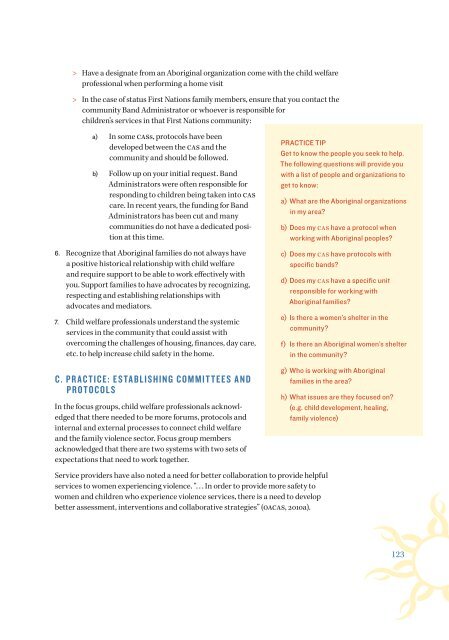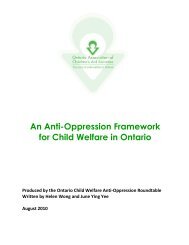English - Ontario Association of Children's Aid Societies
English - Ontario Association of Children's Aid Societies
English - Ontario Association of Children's Aid Societies
Create successful ePaper yourself
Turn your PDF publications into a flip-book with our unique Google optimized e-Paper software.
Have a designate from an Aboriginal organization come with the child welfare<br />
pr<strong>of</strong>essional when performing a home visit<br />
> > In the case <strong>of</strong> status First Nations family members, ensure that you contact the<br />
community Band Administrator or whoever is responsible for<br />
children’s services in that First Nations community:<br />
a) In some CASs, protocols have been<br />
developed between the CAS and the<br />
community and should be followed.<br />
b) Follow up on your initial request. Band<br />
Administrators were <strong>of</strong>ten responsible for<br />
responding to children being taken into CAS<br />
care. In recent years, the funding for Band<br />
Administrators has been cut and many<br />
communities do not have a dedicated position<br />
at this time.<br />
6. Recognize that Aboriginal families do not always have<br />
a positive historical relationship with child welfare<br />
and require support to be able to work effectively with<br />
you. Support families to have advocates by recognizing,<br />
respecting and establishing relationships with<br />
advocates and mediators.<br />
7. Child welfare pr<strong>of</strong>essionals understand the systemic<br />
services in the community that could assist with<br />
overcoming the challenges <strong>of</strong> housing, finances, day care,<br />
etc. to help increase child safety in the home.<br />
PRACTICE TIP<br />
Get to know the people you seek to help.<br />
The following questions will provide you<br />
with a list <strong>of</strong> people and organizations to<br />
get to know:<br />
a) What are the Aboriginal organizations<br />
in my area<br />
b) Does my CAS have a protocol when<br />
working with Aboriginal peoples<br />
c) Does my CAS have protocols with<br />
specific bands<br />
d) Does my CAS have a specific unit<br />
responsible for working with<br />
Aboriginal families<br />
e) Is there a women’s shelter in the<br />
community<br />
f) Is there an Aboriginal women’s shelter<br />
in the community<br />
C. PRACTICE: ESTABLISHING COMMITTEES AND<br />
PROTOCOLS<br />
In the focus groups, child welfare pr<strong>of</strong>essionals acknowledged<br />
that there needed to be more forums, protocols and<br />
internal and external processes to connect child welfare<br />
and the family violence sector. Focus group members<br />
acknowledged that there are two systems with two sets <strong>of</strong><br />
expectations that need to work together.<br />
Service providers have also noted a need for better collaboration to provide helpful<br />
services to women experiencing violence. “. . . In order to provide more safety to<br />
women and children who experience violence services, there is a need to develop<br />
better assessment, interventions and collaborative strategies” (OACAS, 2010a).<br />
g) Who is working with Aboriginal<br />
families in the area<br />
h) What issues are they focused on<br />
(e.g. child development, healing,<br />
family violence)<br />
123

















